Trends in Brazil’s Forestry Education—Part 2: Mismatch between Training and Forest Sector Demands
Abstract
:1. Introduction
2. Materials and Methods
2.1. Interviews with Human Resources Personnel and Forest Managers
2.2. GAP Analysis of a Questionnaire Applied to Professionals on Relevant Skills and on the Training of New Graduates
2.3. Survey of Job Advertisements Using Social Media, E-Mail, and Company Websites
2.4. Questionnaire Distributed to New Graduates about Their Perception of the Main Skills Needed
2.5. Study Limitations
2.6. Statistical Analysis
3. Results
3.1. Trends and Current Scenario of Forest-Engineering Jobs in IPEF-Connected Organizations
3.2. Importance of Skills and Performance of New graduates
3.3. Survey of Job Offers for New Graduates in Forest Engineering
3.4. Perceptions of New Graduates’ Skills’ Relevance and Importance
4. Discussion
4.1. Extension Activities and Professional Experience
4.2. Bringing the Labor Market to Academia
4.3. Curriculum Modifications
5. Conclusions
Author Contributions
Funding
Data Availability Statement
Acknowledgments
Conflicts of Interest
References
- Perlin, J. A Forest Journey: The Story of Wood and Civilization; The Countryman Press: Vermont, VT, USA, 2005. [Google Scholar]
- FAO. The State of the World’s Forests 2018—Forest Pathways to Sustainable Development; FAO: Rome, Italy, 2018. [Google Scholar]
- Schmithüsen, F.J. Three hundred years of applied sustainability in forestry. Working papers/Forest Policy and Forest Economics Department of Forest Sciences. Int. Ser. 2013, 2013, 3–11. [Google Scholar] [CrossRef]
- Beanblossom, R. Biltmore-The Beginning of Forestry Education in America. J. For. 2020, 118, 452–454. [Google Scholar] [CrossRef]
- Macedo, J.E.P.; Amaral Machado, S.d. A Engenharia Florestal da Universidade Federal do Paraná: História e Evolução da Primeira do Brasil; Os Editores: Paraná, Brazil, 2003. [Google Scholar]
- Arevalo, J.; Pitknen, S.; Kirongo, B. Developing forestry curricula: Experiences from a Kenyan-Finnish project. Int. For. Rev. 2014, 16, 78–86. [Google Scholar]
- FAO. The State of the World’s Forests 2022. Forest Pathways for Green Recovery and Building Inclusive, Resilient and Sustainable Economies; FAO: Rome, Italy, 2022. [Google Scholar]
- Li, Y.; Mei, B.; Linhares-Juvenal, T.; Formenton Cardoso, N.; Tshering, C. Forest Sector Contribution to National Economies 2015: The Direct, Indirect and Induced Effects on Value Added, Employment and Labour Income; FAO: Rome, Italy, 2022; Volume 33. [Google Scholar]
- IBA. Relatório Anual IBA 2022. Available online: https://www.iba.org/datafiles/publicacoes/relatorios/relatorio-anual-iba2022-compactado.pdf (accessed on 5 August 2023).
- Hakamada, R.; Frosini de Barros Ferraz, S.; Moré Mattos, E.; Sulbarán-Rangel, B. Trends in Brazil’s Forestry Education: Overview of the Forest Engineering Programs. Forests 2023, 14, 1644. [Google Scholar] [CrossRef]
- Gutiérrez Rojas, I.R.; Peralta Benítez, H.; Fuentes González, H.C. Integración de la investigación y la enseñanza en las universidades médicas. Educ. Médica 2019, 20, 49–54. [Google Scholar] [CrossRef]
- Sample, V.A.; Bixler, R.P.; McDonough, M.H.; Bullard, S.H.; Snieckus, M.M. The Promise and Performance of Forestry Education in the United States: Results of a Survey of Forestry Employers, Graduates, and Educators. J. For. 2015, 113, 528–537. [Google Scholar] [CrossRef]
- Brown, T.L.; Lassoie, J.P. Entry-level competency and skill requirements of foresters: What do employers want? J. For. 1998, 96, 8–14. [Google Scholar]
- Bettinger, P.; Merry, K.L.; Cieszewski, C.J. The importance of mapping technology knowledge and skills for students seeking entry-level forestry positions: Evidence from job advertisements. Math. Comput. For. Nat. Resour. Sci. 2016, 8, 14–24. [Google Scholar]
- Merry, K.; Bettinger, P.; Grebner, D.L.; Boston, K.; Siry, J. Assessment of Geographic Information System (GIS) Skills Employed by Graduates from Three Forestry Programs in the United States. Forest 2016, 7, 304. [Google Scholar] [CrossRef]
- Arevalo, J.; Mola-Yudego, B.; Pelkonen, P.; Qu, M. Students’ views on forestry education: A cross-national comparison across three universities in Brazil, China and Finland. For. Policy Econ. 2012, 25, 123–131. [Google Scholar] [CrossRef]
- Arevalo, J.J.; Pitkänen, S.; Tahvanainen, L.; Enkenberg, J. Differences in Forestry Students’ Perceptions across Study Years in a Brazilian Undergraduate Program. J. Nat. Resour. Life Sci. Educ. 2010, 39, 94–101. [Google Scholar] [CrossRef]
- Mgaga, P.; Scholes, M.C. Does tertiary education in South Africa equip professional foresters for the future? South. For. A J. For. Sci. 2019, 81, 377–385. [Google Scholar] [CrossRef]
- Hakamada, R.E.; Ferraz, S.F.B.; Sulbaran, B.R.; Lucena, L.; Hinestroza, H. Trends in Brazil’s Forestry Education. Part 3: Where do the forest engineers work? Case study from two public universities in the past 15 years. Forests, 2013; in press. [Google Scholar] [CrossRef]
- Collins, K.; Davies, J. Feedback through student essay competitions: What makes a good engineering lecturer? J. Eng. Educ. 2009, 4, 8–15. [Google Scholar] [CrossRef]
- Buckley, A.; Soilemetzidis, I.; Hillman, N. The 2015 Student Academic Experience Survey; The Higher Education Policy Institute and Higher Education Academy: London, UK, 2015. [Google Scholar]
- Pinchot, G. The Profession of Forestry; American Forestry Association: Chicago, IL, USA, 1903. [Google Scholar]
- Cheng, M.; Lee, K.; Chan, C. Generic skills development in discipline-specific courses in higher education: A systematic literature review. Curric. Teach. 2018, 33, 47–65. [Google Scholar] [CrossRef]
- Chan, C.K.; Luk, L.Y. Faculty Perspectives on the” 3+ 3+ 4” Curriculum Reform in Hong Kong: A Case Study. J. Int. Educ. Stud. 2013, 6, 56–66. [Google Scholar] [CrossRef]
- Boulton, G.; Lucas, C. What are universities for? Chin. Sci. Bull. 2011, 56, 2506–2517. [Google Scholar] [CrossRef]
- EUPA; Universidade do Estado do Pará. Edital n° 066/2023—CCNT/UEPA. Available online: https://prograd.uepa.br/index.php/editais/ (accessed on 3 August 2023).
- Ministério da Educação. Resolução Nº 009/2019. Regulamenta Procedimentos para as Progressões Funcionais e Promoções das Carreiras de Magistério Superior e do Ensino Básico, Técnico e Tecnológico na Universidade Federal Rural de Pernambuco. 2019. Available online: http://200.17.137.52/sites/200.17.137.52/files/RESOLU%C3%87%C3%83O%20CONSU%20N%C2%BA%2009.2019%20-%20PROGRESS%C3%83O%20E%20PROMO%C3%87%C3%83O%20DOCENTE.pdf (accessed on 3 August 2023).
- Pilcher, N.; Galbrun, L.; Craig, N.; Murray, M.; Forster, A.M.; Tennant, S. Role requirements in academic recruitment for Construction and Engineering. Eur. J. Eng. Educ. 2021, 46, 247–265. [Google Scholar] [CrossRef]
- Pilcher, N.; Forster, A.; Tennant, S.; Murray, M.; Craig, N. Problematising the ‘Career Academic’in UK construction and engineering education: Does the system want what the system gets? Eur. J. Eng. Educ. 2017, 42, 1477–1495. [Google Scholar] [CrossRef]
- Fung, D.; Besters-Dilger, J.; Van der Vaart, R. Excellent education in research-rich universities. In Proceedings of the VSNU -EUA Conference on Recognition & Rewards, Rotterdam, The Netherlands, 15 November 2019. [Google Scholar]
- Diário Oficial da Uniao. Portaria Nº 193 de 16 de Junho de 2020. Available online: https://catalogo.ipea.gov.br/uploads/498_2.pdf (accessed on 3 August 2023).
- SIF. Society of Forest Investigations. Available online: https://sif.org.br/ (accessed on 5 August 2023).
- IPEF. Institute of Research and Forestry Studies. Available online: https://www.ipef.br/ (accessed on 5 August 2023).
- Owuor, J.; Rodríguez-Piñeros, S. Best Practices in Forest Education in Europe from the Global Best Practices Competition. In Twenty Years after the Bologna Declaration Challenges for Higher Forestry Education; Schmidt, P.L.S., Weber, N., Eds.; Technische Universität Dresden: Dresden, Germany; The Sächsische Landesbibliothek: Dresden, Germany, 2019; p. 73. [Google Scholar]
- Rodríguez-Piñeros, S.; Walji, K.; Rekola, M.; Owuor, J.A.; Lehto, A.; Tutu, S.A.; Giessen, L. Innovations in forest education: Insights from the best practices global competition. For. Policy Econ. 2020, 118, 102260. [Google Scholar] [CrossRef]
- Presidência da República. Lei 13.267, de 6 de abril de 2016. Disciplina a Criação e a Organização das Associações Denominadas Empresas Juniores, com Funcionamento Perante Instituições de Ensino Superior. 2016. Available online: https://www.planalto.gov.br/ccivil_03/_ato2015-2018/2016/lei/l13267.htm (accessed on 5 August 2023).
- IBGE. Censo Demográfico 2020 Rio de Janeiro; Brazilian Institute of Geography and Statistics: Rio de Janeiro, Brazil, 2020.
- Árvores, I.B.d. Relatório Anual IBA; IBA: São Paulo, Brazil, 2023; p. 96. [Google Scholar]
- Service, B.F. Produção da Extração Vegetal e Silvicultura. Available online: https://snif.florestal.gov.br/pt-br/producao (accessed on 5 August 2023).
- EMBRAPA. Nota Técnica: Integração Lavoura Pecuária Floresta; EMBRAPA: Brasilia, Brazil, 2021. [Google Scholar]
- Fischer, J.; Riechers, M.; Loos, J.; Martin-Lopez, B.; Temperton, V.M. Making the UN decade on ecosystem restoration a social-ecological endeavour. Trends Ecol. Evol. 2021, 36, 20–28. [Google Scholar] [CrossRef]
- Camara do Diputado. Legislação Informatizada—LEI Nº 13.005, DE 25 DE JUNHO DE 2014—Publicação Original. 2014. Available online: https://www2.camara.leg.br/legin/fed/lei/2014/lei-13005-25-junho-2014-778970-publicacaooriginal-144468-pl.html (accessed on 5 August 2023).
- John, L.I. Multidisciplinarity, interdisciplinarity and training in forestry and forest research. For. Chron. 2005, 81, 324–329. [Google Scholar] [CrossRef]
- Temu, A.; Kiwia, A. Future Forestry Education: Responding to Expanding Societal Needs; International Partnerships for Forestry Educations: Nairobi, Kenya, 2008. [Google Scholar]
- Bullard, S.H. Forestry Curricula for the 21st Century-Maintaining Rigor, Communicating Relevance, Building Relationships. J. For. 2015, 113, 552–556. [Google Scholar] [CrossRef]
- Arevalo, J.; Tahvanainen, L.; Pitkänen, S.; Enkenberg, J. Motivation of Foreign Students Seeking a Multi-Institutional Forestry Master’s Degree in Europe. J. For. 2011, 109, 69–73. [Google Scholar] [CrossRef]
- Arevalo, J.; Pitkänen, S.; Gritten, D.; Tahvanainen, L. Market-Relevant Competencies for Professional Foresters in European Graduate Education. Int. For. Rev. 2010, 12, 200–208. [Google Scholar] [CrossRef]
- Kammesheidt, L.; Idrus, R.M.; Trockenbrodt, M.; Hahn-Schilling, B. Linking academic forestry education with employers’ demands: A case study from Malaysia. Int. For. Rev. 2007, 9, 661–669. [Google Scholar] [CrossRef]
- Lloyd, D.; Nichols, J.D.; Taffs, K.H.; Vanclay, J.K. Forestry at Southern Cross University: Fifteen years in review. Int. For. Rev. 2011, 13, 500–510. [Google Scholar] [CrossRef]
- Ameyaw, J.; Arts, B.; Wals, A.E.J. Challenges to Responsible Forest Governance in Ghana and Its Implications for Professional Education. For. Policy Econ. 2016, 62, 78–87. [Google Scholar] [CrossRef]
- Contreras-Hermosilla, A. People, Governance and Forests-The Stumbling Blocks in Forest Governance Reform in Latin America. Forests 2011, 2, 168–199. [Google Scholar] [CrossRef]
- Merry, K.L.; Bettinger, P.; Clutter, M.; Hepinstall, J.; Nibbelink, N.P. An assessment of geographic information system skills used by field-level natural resource managers. J. For. 2007, 105, 364–370. [Google Scholar]
- Federal Rural University of Pernambuco. Taxa de Sucesso na Graduação (TSG). Available online: http://www.proplan.ufrpe.br/content/taxa-de-sucesso-na-gradua%C3%A7%C3%A3o-tsg (accessed on 5 August 2023).
- Costa, F.J.d.; Bispo, M.d.S.; Pereira, R.d.C.d.F. Dropout and retention of undergraduate students in management: A study at a Brazilian Federal University. RAUSP Manag. J. 2018, 53, 74–85. [Google Scholar] [CrossRef]
- Mangum, W.M.; Baugher, D.; Winch, J.K.; Varanelli, A. Longitudinal Study of Student Dropout From a Business School. J. Educ. Bus. 2005, 80, 218–221. [Google Scholar] [CrossRef]
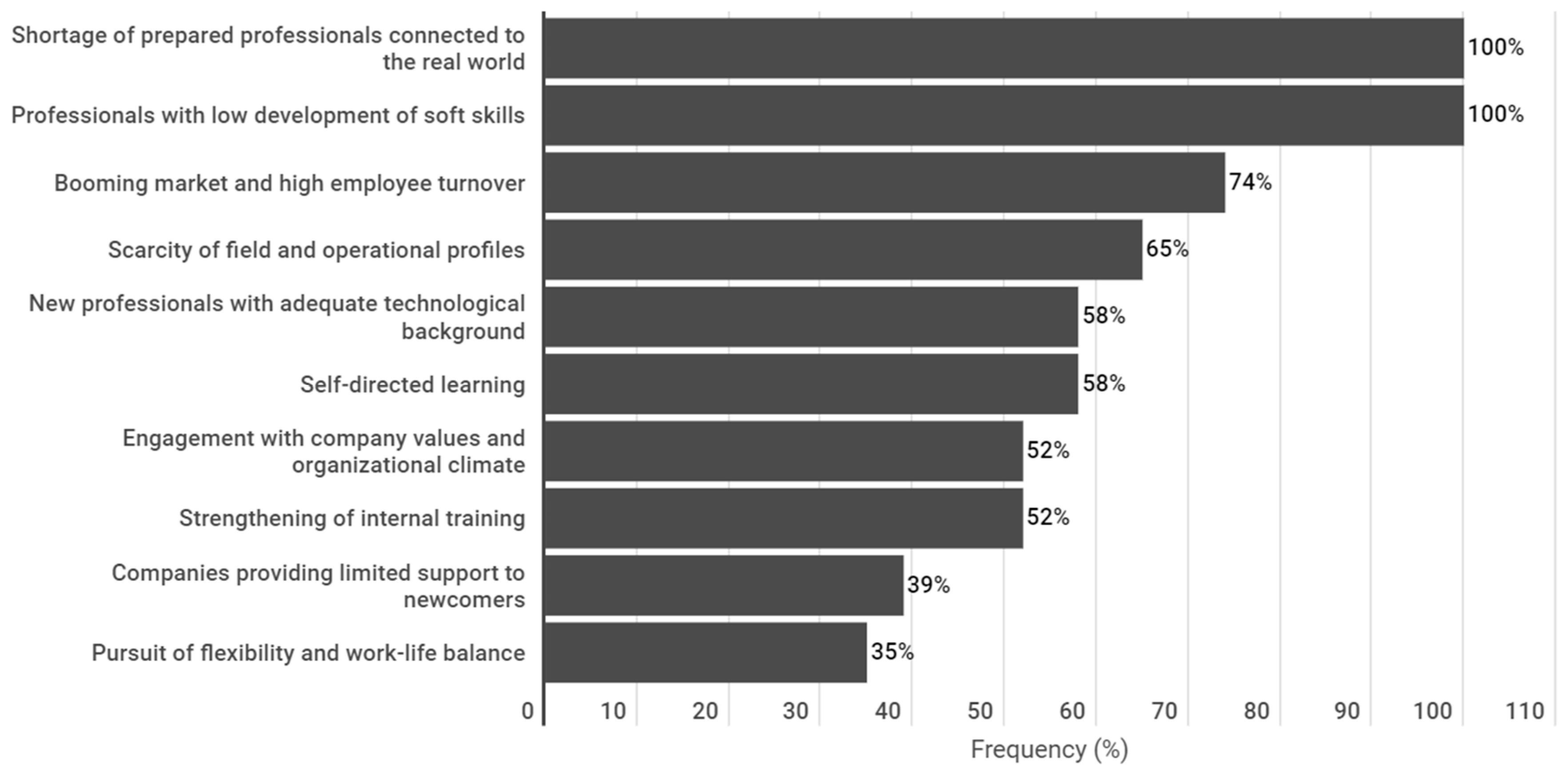
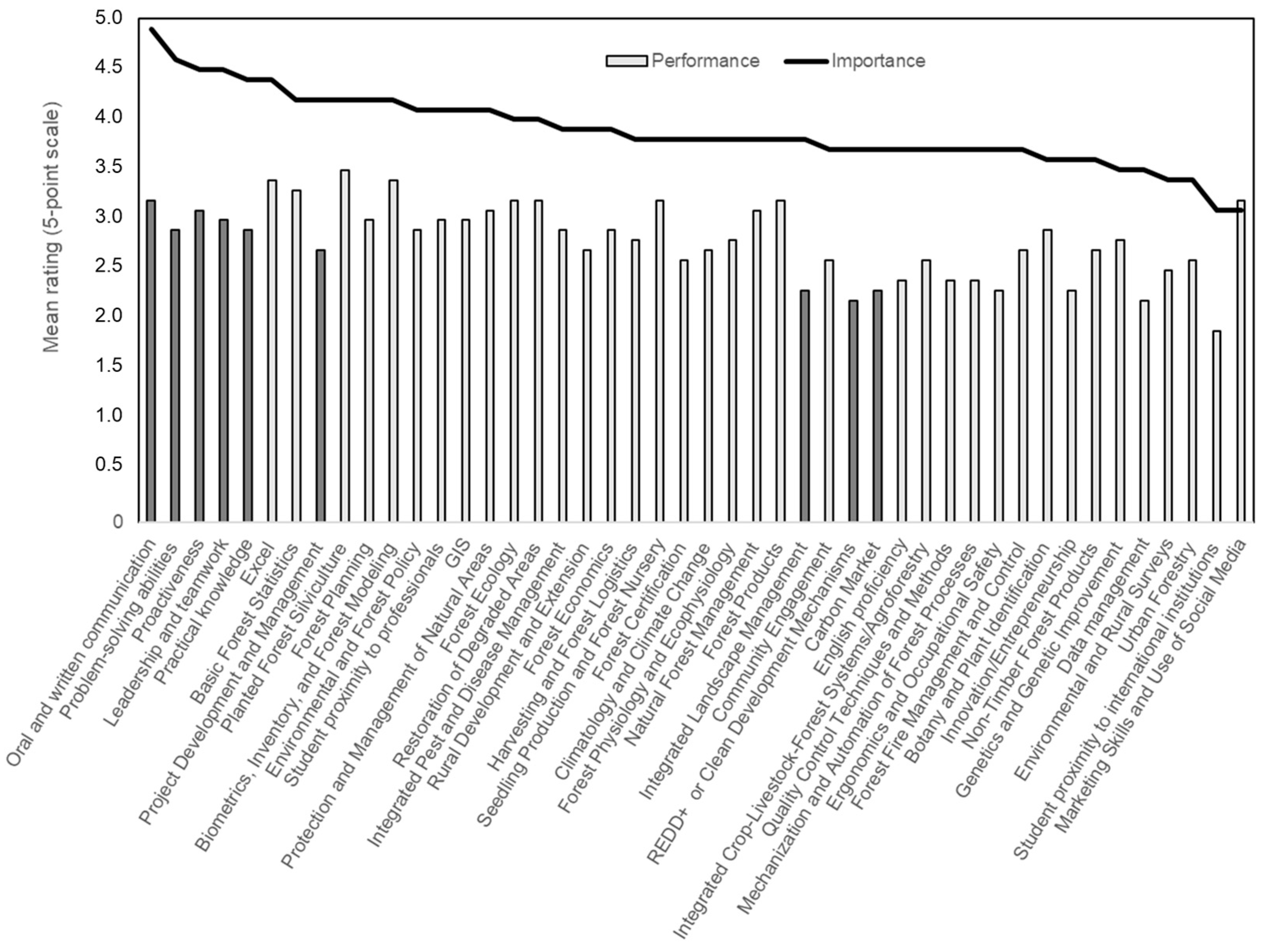
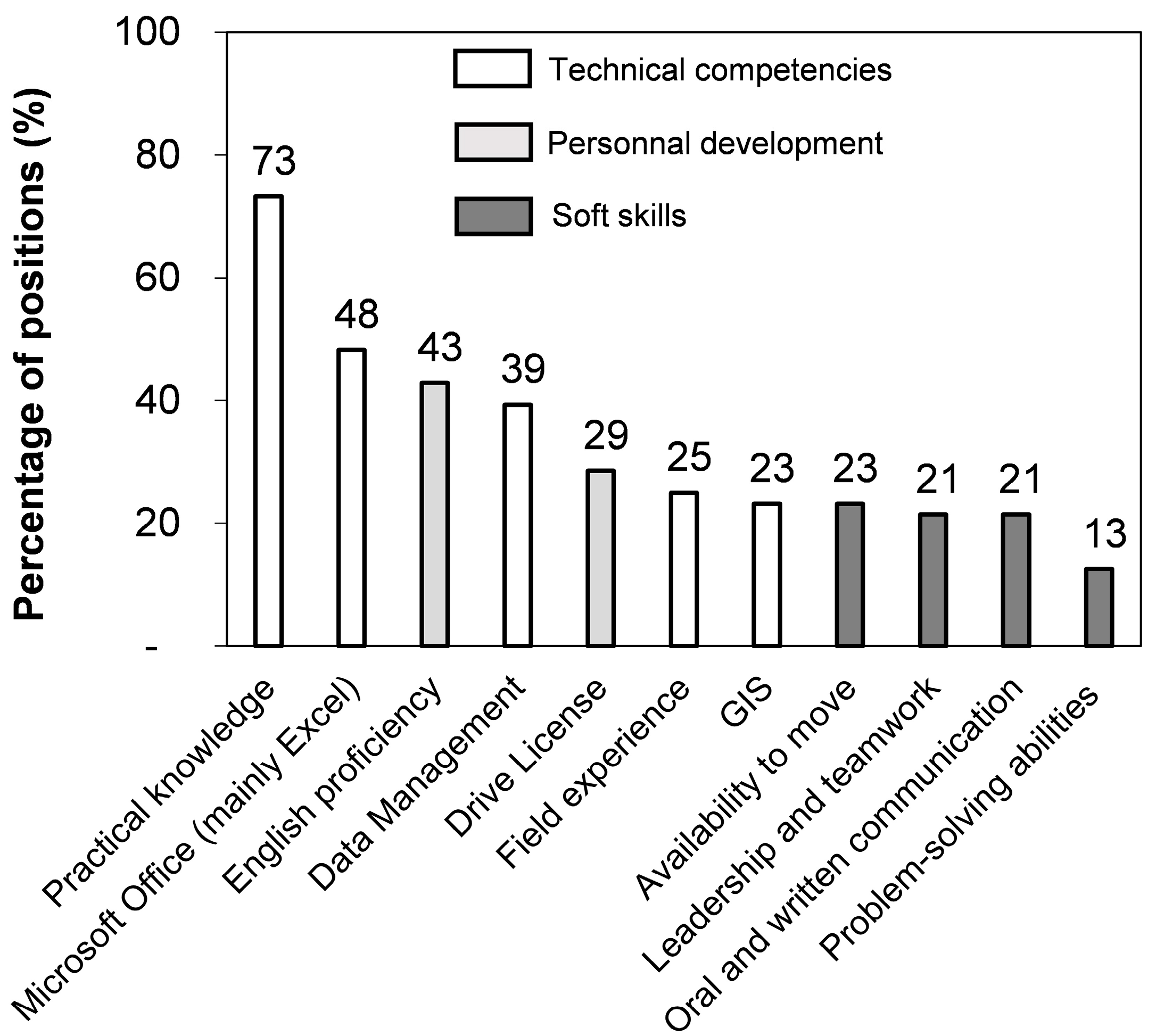
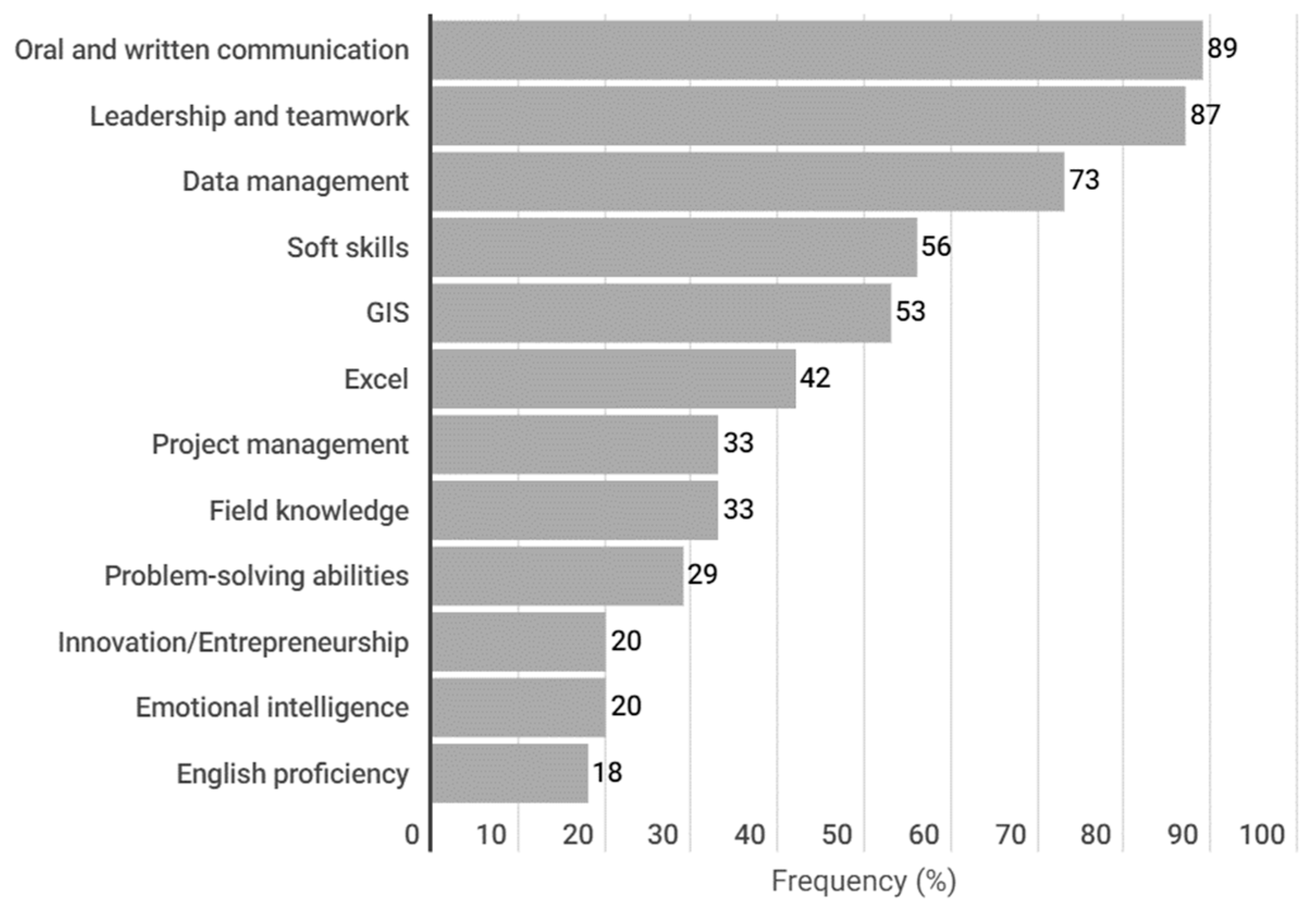
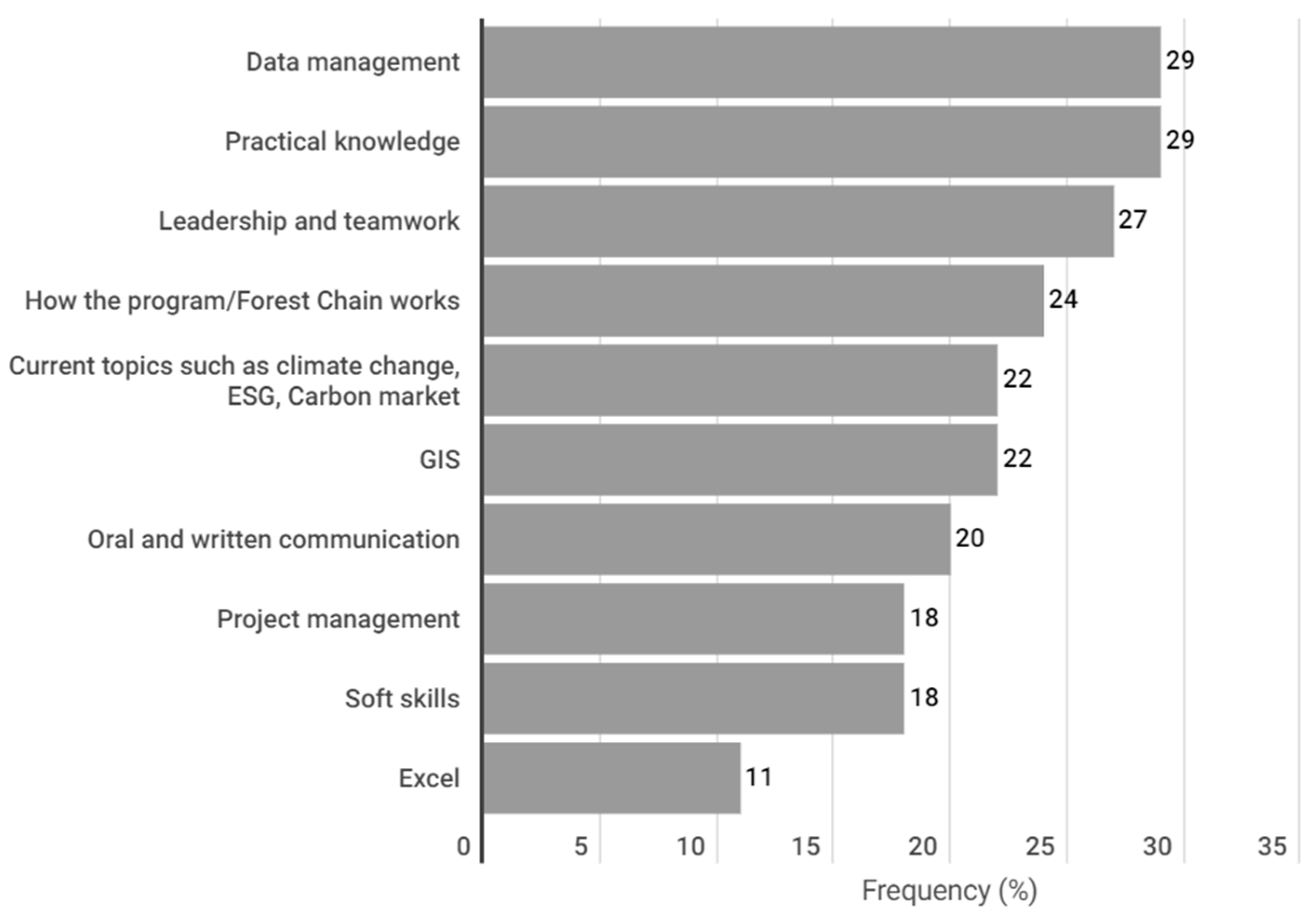
Disclaimer/Publisher’s Note: The statements, opinions and data contained in all publications are solely those of the individual author(s) and contributor(s) and not of MDPI and/or the editor(s). MDPI and/or the editor(s) disclaim responsibility for any injury to people or property resulting from any ideas, methods, instructions or products referred to in the content. |
© 2023 by the authors. Licensee MDPI, Basel, Switzerland. This article is an open access article distributed under the terms and conditions of the Creative Commons Attribution (CC BY) license (https://creativecommons.org/licenses/by/4.0/).
Share and Cite
Hakamada, R.; Frosini de Barros Ferraz, S.; Sulbaran-Rangel, B. Trends in Brazil’s Forestry Education—Part 2: Mismatch between Training and Forest Sector Demands. Forests 2023, 14, 1805. https://doi.org/10.3390/f14091805
Hakamada R, Frosini de Barros Ferraz S, Sulbaran-Rangel B. Trends in Brazil’s Forestry Education—Part 2: Mismatch between Training and Forest Sector Demands. Forests. 2023; 14(9):1805. https://doi.org/10.3390/f14091805
Chicago/Turabian StyleHakamada, Rodrigo, Silvio Frosini de Barros Ferraz, and Belkis Sulbaran-Rangel. 2023. "Trends in Brazil’s Forestry Education—Part 2: Mismatch between Training and Forest Sector Demands" Forests 14, no. 9: 1805. https://doi.org/10.3390/f14091805
APA StyleHakamada, R., Frosini de Barros Ferraz, S., & Sulbaran-Rangel, B. (2023). Trends in Brazil’s Forestry Education—Part 2: Mismatch between Training and Forest Sector Demands. Forests, 14(9), 1805. https://doi.org/10.3390/f14091805






